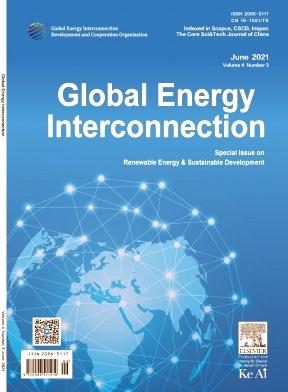Flexible linear clock–based distributed self-triggered active power-sharing secondary control of AC microgrids
IF 1.9
Q4 ENERGY & FUELS
引用次数: 0
Abstract
Traditional active power sharing in microgrids, achieved by the distributed average consensus, requires each controller to continuously trigger and communicate with each other, which is a wasteful use of the limited computation and communication resources of the secondary controller. To enhance the efficiency of secondary control, we developed a novel distributed self-triggered active power-sharing control strategy by introducing the signum function and a flexible linear clock. Unlike continuous communication–based controllers, the proposed self-triggered distributed controller prompts distributed generators to perform control actions and share information with their neighbors only at specific time instants monitored by the linear clock. Therefore, this approach results in a significant reduction in both the computation and communication requirements. Moreover, this design naturally avoids Zeno behavior. Furthermore, a modified triggering condition was established to achieve further reductions in computation and communication. The simulation results confirmed that the proposed control scheme achieves distributed active power sharing with very few controller triggers, thereby substantially enhancing the efficacy of secondary control in MGs.
基于柔性线性时钟的交流微电网分布式自触发有功共享二次控制
传统的微电网有功共享是通过分布式平均共识实现的,要求各控制器之间不断触发和通信,这是对次级控制器有限的计算和通信资源的浪费。为了提高二次控制的效率,我们通过引入sgum函数和柔性线性时钟,开发了一种新的分布式自触发有源功率共享控制策略。与基于连续通信的控制器不同,所提出的自触发分布式控制器仅在线性时钟监控的特定时刻提示分布式发电机执行控制动作并与邻居共享信息。因此,这种方法大大减少了计算和通信需求。此外,这种设计自然地避免了芝诺行为。在此基础上,提出了一种改进的触发条件,进一步减少了计算量和通信量。仿真结果表明,所提出的控制方案在很少的控制器触发下实现了分布式有功共享,从而大大提高了MGs的二次控制效率。
本文章由计算机程序翻译,如有差异,请以英文原文为准。
求助全文
约1分钟内获得全文
求助全文
来源期刊

Global Energy Interconnection
Engineering-Automotive Engineering
CiteScore
5.70
自引率
0.00%
发文量
985
审稿时长
15 weeks
 求助内容:
求助内容: 应助结果提醒方式:
应助结果提醒方式:


